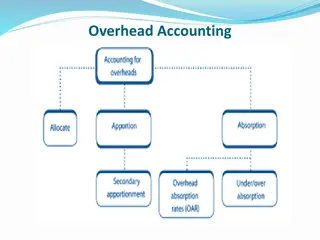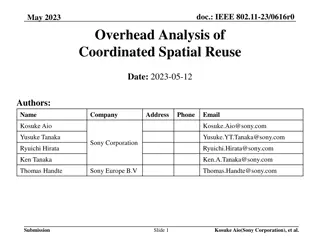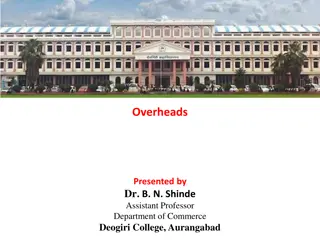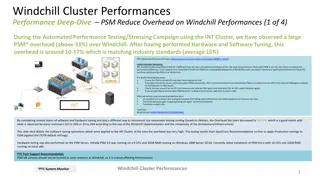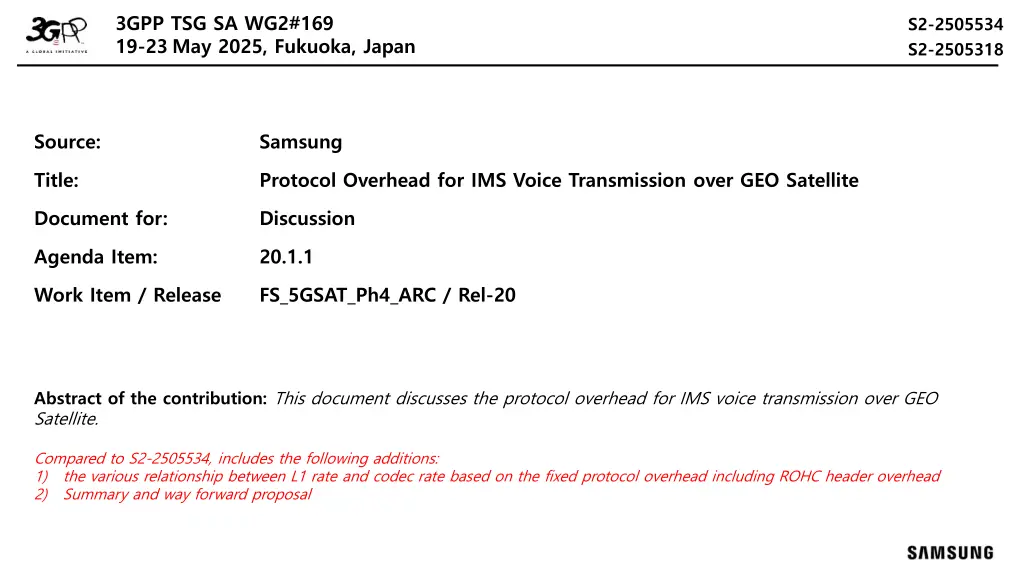
IMS Voice Transmission Protocol Overhead Analysis
This document analyzes the protocol overhead for IMS voice transmission over GEO satellites, focusing on the relationship between L1 rate, codec rate, and fixed protocol overhead. It discusses options for delivering voice data and the required physical layer rates for different codecs, emphasizing the importance of header compression. The document also proposes a summary and a way forward for this topic.
Download Presentation

Please find below an Image/Link to download the presentation.
The content on the website is provided AS IS for your information and personal use only. It may not be sold, licensed, or shared on other websites without obtaining consent from the author. If you encounter any issues during the download, it is possible that the publisher has removed the file from their server.
You are allowed to download the files provided on this website for personal or commercial use, subject to the condition that they are used lawfully. All files are the property of their respective owners.
The content on the website is provided AS IS for your information and personal use only. It may not be sold, licensed, or shared on other websites without obtaining consent from the author.
E N D
Presentation Transcript
3GPP TSG SA WG2#169 19-23 May 2025, Fukuoka, Japan S2-2505534 S2-2505318 Source: Samsung Title: Protocol Overhead for IMS Voice Transmission over GEO Satellite Document for: Discussion Agenda Item: 20.1.1 Work Item / Release FS_5GSAT_Ph4_ARC / Rel-20 Abstract of the contribution: This document discusses the protocol overhead for IMS voice transmission over GEO Satellite. Compared to S2-2505534, includes the following additions: 1) the various relationship between L1 rate and codec rate based on the fixed protocol overhead including ROHC header overhead 2) Summary and way forward proposal
Assumptions IP Multimedia Subsystem (IMS) client is in the UE and IMS network is in the network Voice transmission is transferred over IP with potential header compression (e.g., ROHC) One packet: Codec data + Protocol Overhead Codec Codec Data Data Protocol Overhead Two options for delivering voice data that are discussed in SA2 35,786 km distance from the earth 285ms signal delays CP transport: NAS/SRB UP transport: UP/DRB MME EPC S/P-GW UE#1 IMS UE#2 ptime (packetization time) 285ms signal delays S1+EPC: 10ms IMS: 40ms EPC-UE2: 30ms Packetization time (ptime) The duration of audio represented in a single RTP packet measured in milliseconds (ms) The actual delay depends on the deployments 2
Option 1. Voice data transmission over UP/DRB When the protocol overhead 7B is assumed, at least 1.3 ~ 3.1 kbps physical rate is required for low bit rate codec (for ptime=80) Required Physical layer rate Overview: Voice data over UP/DRB Voice data is transmitted over DRB/UP ROHC is located in eNB PHY rate (kbps) PHY rate with 7B overhead S/P-GW 6.0 ptime: 20ms A-GW UE2 GTP-U DRB UE1 5.0 Codec Data Codec Data Protocol Overhead ptime: 40ms 4.0 ptime (packetization time) ptime: 80ms ptime: 160ms 3.0 Protocol overhead total 7B for each voice codec data (ptime=80ms) Voice Codec Rate Protocol Overhead Voice Data PHY rate 2.0 ROHC 3B* 0.6 kbps 7 B 6 B 1.3 kbps PDCP 1B 1.0 1.2 kbps 7 B 12 B 1.9 kbps RLC (UM) 1B 2.4 kbps 7 B 24 B 3.1 kbps MAC 2B 0.0 0 0.5 1 1.5 2 2.5 3 * ROHC: IR state in ROHC, uncompressed RTP/UDP/IP Header to be transferred Codec rate (kbps) 3
Option 1a. Voice data transmission over UP/DRB (ROHC 1B) When the protocol overhead 7B is assumed, at least 1.3 ~ 3.1 kbps physical rate is required for low bit rate codec (for ptime=80) L1 rate vs. Codec rate Overview: Voice data over UP/DRB Voice data is transmitted over DRB/UP ROHC is located in eNB L1 rate (kbps) PHY rate with the protocol overhead (5B per each packet) S/P-GW 9.0 A-GW UE2 GTP-U DRB UE1 ptime: 20ms 8.0 Codec Data Codec Data Protocol Overhead 7.0 ptime (packetization time) 6.0 ptime: 40ms 5.0 Protocol overhead total 7B for each voice codec data (ptime=80ms) ptime: 80ms 4.0 Voice Codec Rate Protocol Overhead Voice Data PHY rate ptime: 160ms 3.0 ROHC 1B* 0.6 kbps 5 B 6 B 1.1 kbps PDCP 1B 2.0 1.2 kbps 5 B 12 B 1.7 kbps RLC (UM) 1B 1.0 2.4 kbps 5 B 24 B 2.9 kbps MAC 2B 0.0 * ROHC header overhead 1) ROHC: IR state in ROHC, uncompressed RTP/UDP/IP Header to be transferred 2) ROHC compressed 1 Byte can be used assuming CID 0 is used. 0 0.5 1 1.5 2 2.5 3 Codec rate (kbps) 4
Option 2. Voice data transmission over NAS/SRB Considering NAS layer protocol overhead, it is not appropriate for the IMS voice data transmission Required Physical layer rate Voice data over CP NAS PHY rate (kbps) Voice data is transmitted over SRB/NAS PHY rate with a fixe overhead (16B) ROHC is located in MME 10.0 9.0 ptime: 20ms S/P-GW MME 8.0 A-GW SRB S1-AP UE2 UE1 7.0 6.0 Protocol overhead total 18B for each voice codec data (ptime=80ms) ptime: 40ms Voice 5.0 ROHC 3B* ptime: 80ms 4.0 NAS 7B** Codec Rate Protocol Overhead Voice Data PHY rate ptime: 160ms 3.0 RRC 2B 0.6 kbps 16 B 6 B 2.2 kbps PDCP 0B 2.0 1.2 kbps 16 B 12 B 2.8 kbps RLC (AM) 2B 1.0 2.4 kbps 16 B 24 B 4.0 kbps MAC 2B 0.0 * ROHC: IR state in ROHC, uncompressed RTP/UDP/IP Header to be transferred 0 0.5 1 1.5 2 2.5 3 Codec rate (kbps) ** NAS overhead can be reduced if NAS reduction is used 5
Option 2a. Voice data transmission over NAS/SRB (ROHC 1B) Considering NAS layer protocol overhead, it is not appropriate for the IMS voice data transmission L1 rate vs. Codec rate Voice data over CP NAS Voice data is transmitted over SRB/NAS ROHC is located in MME PHY rate with the protocol overhead (14B per each packet) L1 rate (kbps) 9.0 S/P-GW MME 8.0 ptime: 20ms A-GW SRB S1-AP UE2 UE1 7.0 Protocol overhead total 18B for each voice codec data (ptime=80ms) 6.0 Voice ptime: 40ms ROHC 1B* 5.0 NAS 7B** Codec Rate Protocol Overhead Voice Data PHY rate 4.0 ptime: 80ms ptime: 160ms RRC 2B 3.0 0.6 kbps 14 B 6 B 2.0 kbps PDCP 0B 1.2 kbps 14 B 12 B 2.6 kbps 2.0 RLC (AM) 2B 2.4 kbps 14 B 24 B 3.8 kbps MAC 2B 1.0 * ROHC header overhead 1) ROHC: IR state in ROHC, uncompressed RTP/UDP/IP Header to be transferred 2) ROHC compressed 1 Byte can be used assuming CID 0 is used. ** NAS overhead can be reduced if NAS reduction is used 0.0 0 0.5 1 1.5 2 2.5 3 Codec rate (kbps) 6
Appendix: 3GPP NAS Protocol Format and Overhead NAS Message Header Format (as specified in 3GPP TS 24.301 section 8.1) Field Name Size Description Protocol Discriminator 4 bits Identifies the NAS message category (e.g., EMM or ESM) Security Header Type 4 bits Indicates the presence and type of security protection Message Authentication Code 4 bytes* Present if security protection is applied Sequence Number 1 byte* Present if security protection is applied Message Type 1 byte Identifies the specific NAS message Summary Security Protection NAS Header Fields Header Size Integrity + Ciphering PD (4b) + SHT (4b) + MAC (4B) + SN (1B) + MT (1B) 7 bytes Ciphering Only PD (4b) + SHT (4b) + SN (1B) + MT (1B) 3 bytes According to TS 24.301, integrity protection is mandatory for NAS signaling, while ciphering is optional. "Ciphering Only" is not explicitly supported or recommended by the 3GPP standard. Most commercial networks always enable integrity protection.
Observation and a way forward Observations Voice data transmission over User Plane better because UP approach has lesser protocol overhead and requires lesser physical rate to transfer voice data for the same codec rate Protocol overhead will impact the requirements for target codec rate also required physical rate ptime also can impact to the physical layer rate and codec rate Proposal for SA2#166 For further analysis and give a information to RAN1 and SA4, let s have a consensus on protocol overhead for CP and UP solutions in SA2 - Agree on ROHC overhead at least (in SO state): 3B or 1B - Agree on NAS/RRC/RLC/MAC protocol overhead including NAS reduction for CP solution - Agree on PDCP/RLC/MAC protocol overhead for UP solution 8













